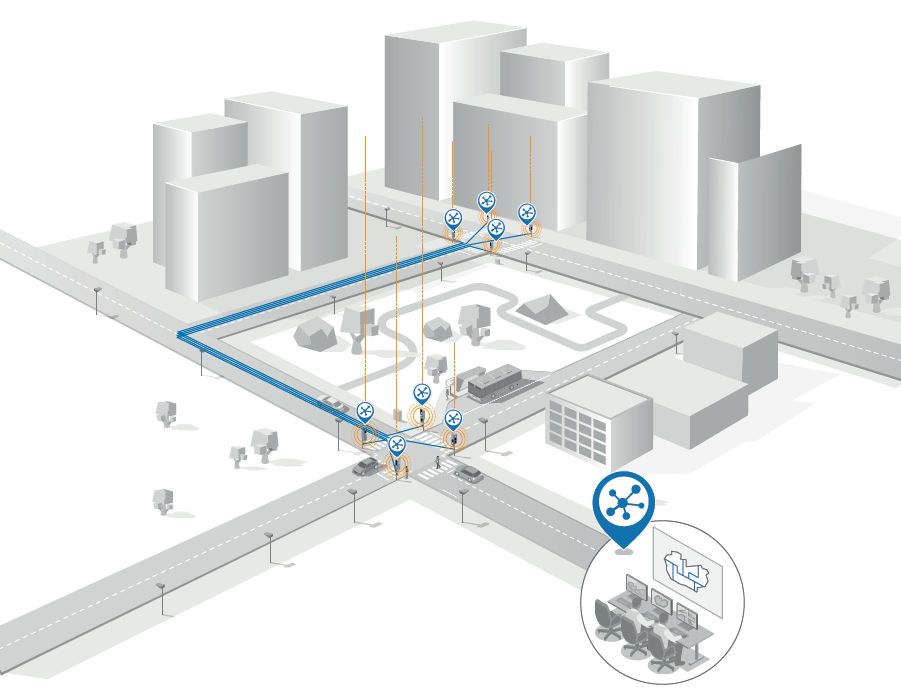The Intersection of Things
TRAFFIC SIGNAL CONTROLLED INTERSECTIONS GET SMARTER WITH SWARCO
At today’s intersections, traffic lights are controlled by a traffic light controller via an electrical interface. This results in traffic lights with little maintenance efficiency. Additionally, value added functionalities cannot be implemented, and energy efficiency still has room for improvement.
With the advent of cost-efficient and reliable field level communication networks, a next step is to introduce an electronic interface between traffic lights and the controller. The SWARCO LINE TECHNOLOGY is based on CAN (Control Area Network) and includes additional safety measures. Each traffic light and traffic controller are designed in such a way to meet the demanding safety requirements of the EN12675, EN 61508 and EN 50556 international standards.

Manuel Milli, SWARCO Solution Manager Smart Mobility and Urban Traffic Control, knows that at its core the new system required developments in three fields: signal heads as part of traffic lights, the traffic controllers, and the interface between both. Not to mention partnering activities with other actuators like signals for blind people or sensors (loops, video, radar). “The CAN protocol has mainly been used in the automotive industry for time critical and reliable applications", says Milli.
“Consequently, it is a well-suited basis for controlling signal heads.” The distributed architecture includes a main controller unit in charge of control and central power switching and the number of pole controllers for distribution of power and data communication to other components of the platform. The ‘intersection of things’ offers a variety of new applications for different stakeholders, i.e. a system integrator of the equipment, an intersection operator, and a road user.
"The CAN protocol
is a well-suited basis for controlling
signal heads"
Manuel Milli
SWARCO Solution Manager
OPEN INTERFACES FOR SMOOTH INTEGRATION
The specification of the CAN-based interface is open for any integrator. The idea is to have a set of mandatory commands (e.g., switch on signal head) to guarantee interoperability among different vendors and system integrators. On the other hand, project-specific requirements can be met by introducing optional commands.
EFFICIENT MAINTENANCE
Traditional signal heads controlled via an electrical interface can only indicate if they are currently working or not. The new solution offers the possibility to retrieve detailed information on a critical failure in the signal head. Non-critical failures and minor incidents can also be reported. Consequently, instead of periodic maintenance, predictive and event-triggered activities are possible. Finally, the functionality can be enhanced, applying service patches remotely via a firmware update.
INCREASED ENERGY EFFICIENCY
In traditional systems, the electrical interface between the traffic light controller and signal head uses the consumed energy as an indicator of whether the signal head works or not. Even in the deactivated mode (i.e. signal off), the power loss is about 6 to 5W depending on the geographical region. The electronic interface enables a dramatic reduction in power loss to 1 or 2W, which results in increased energy efficiency. Moreover, due to minimal power consumption of LEDs, electrical disturbances on the line can be eliminated and the supervision is more robust.
INCREASED ENERGY EFFICIENCY
Firstly, the solution is fully compliant with the requirements of EN61508, SIL 3, i.e. the system’s residual failure probability rate is at least below 10-7 failures per hour. As a result, the platform contributes significantly to ensuring that traffic safety at the intersection is inherently safe. Secondly, the platform not only mitigates the risk coming from dangerous failures (i.e. failures comprising the safety integrity of the equipment), but also handles non-dangerous failures with high occurrences resulting in very high reliability and availability with extremely limited downtimes. The ‘intersection of things,’ with its CANbased network and full compliance with product and safety standards, enables new services and supports the concept of Internet of Things (IoT). In addition to signal heads, any sensor (detectors, air quality sensors, etc.) can be connected. Therefore, more data elements are collected, and services based upon these may be implemented. Moreover, connected intersections are a key element in making the infrastructure ready for connected and automated driving. Retrieving data elements from connected sensors with very low latency and bringing them to bypassing vehicles, may help to increase the situation awareness of the automated vehicles. For the time being, automated vehicles with state-of-the-art sensor technology are not able to recognize the current situation at an intersection and react to critical situations in a very short time frame.